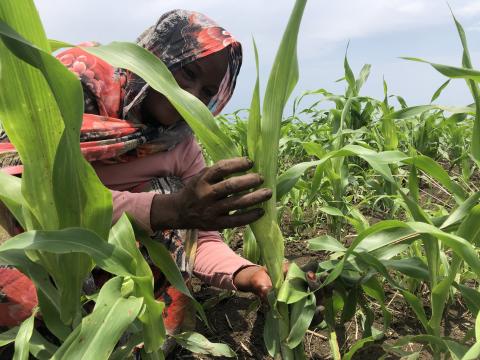Sorghum farmers in Sudan's Blue Nile anticipate bumper harvests as project comes to an end

For most of 2019, the deteriorating economic situation in Sudan, has taken a heavy toll on most households. Currency, fuel and food shortages have left households even more vulnerable. As the planting and cultivation season approached in May-June, without some kind of assistance, most sorghum farmers would have missed the opportunity to plant this year.
Through funding from the European Commission, more than 1,000 farmers across three localities in the Blue Nile state, southeast of Sudan, received support this season to grow sorghum, a staple in most Sudanese households.
In Roseries localities for example, this planting season the project supported 300 farmers. Through the project, farmers received support in the form of: mechanised services for land cultivation, fertiliser application and weeding as well as threshing and harvesting through a voucher system. Cultivation, planting, weeding, fertiliser application and spraying have already been achieved.
Often, farmers are expected to be present in the farms as all the above is being done and if they have any complaints they have been empowered to raise them.
For now, the farmers watch and wait as the rains continue to fall on their sorghum fields. They hope that soon they will begin to flower. Come October through to December of this year, the machines will return again, this time supporting the farmers with the harvesting and threshing processes.
Aisha Mohammed, one of the beneficiaries expresses confidence that this year’s harvests will be bigger. In 2017, when she first joined the project, she harvested 50 bags, weighing 50 kilogrammes each. “Then my yield improved to 85 bags in 2018,” she offers.
Aisha takes care of her seven children as well as other members of her extended family. One of the exciting things about this type of farming she says is that virtually all the farming activities are mechanised, affording farmers time to engage in other activities.
“In the past, because the farming was labour intensive, we spent long hours in the farms,” Aisha notes. "However, now because farming is largely mechanised, we have some time to spend with our children and also do other things,” she adds, an observation to which Alawia, another beneficiary, nods in agreement.
Collectively, the farmers own 1,500 feddans (approximately 1,500 acres) on which the sorghum has been planted. For easier provision of the mechanised services, the farmers are divided into clusters of 10 farmers per cluster, with each owning 5 feddans of land and collectively 50 feddans.
Women overcome land ownership rights limitations
In some areas in Sudan, women don’t have land ownership rights and thus land belongs to the men, leaving women with limited choices when it comes to farming.
This didn’t discourage the women from securing land nonetheless. At a cost of 2,000 Sudanese Pounds (approximately $45 USD), Aisha and dozen other women have rented parcels of land, for the entire sorghum season, which typically lasts from May/June to November/ December.
While the mechanised farming supports only sorghum growing, on their own the farmers also grow other crops, such as okra, cowpeas and groundnuts. Others have used their spare time to operate small businesses.
About the European Commission project
One of the things that the project has strived to achieve is to gradually reduce high dependency by increasing farmers’ contributions so that by the end of the project, there’s full ownership.
In 2016, for example, the project provided 90% of machinery and input support while the farmers’ contribution was 10%. By 2018 the farmers’ contribution had reached 30% and it was hoped that in 2019 farmers would contribute 50%. However, due to the worsening economic situation (the high costs of inputs), this was impossible to achieve and the farmers' contributions actually reduced to 25%.
A critical objective for the project has also been to link farmers with credit and marketing institutions. For those farmers who can’t raise the money to finance their sorghum farming on their own, World Vision has helped link them to microfinance institutions in Blue Nile, that provide credit to farmers, in order for them to access some of the mechanised farming services from the contracted company.
Through these credit facilities, farmers are financed to buy farming inputs and repay according to the terms of the agreements. According to Monir Abdalla, coordinator of the Europen Ccommission project, payment often varies. It can be payment in-kind, which basically means the farmers give a number of sorghum bags or cash.
"In the past, farmers received inputs directly and this became prone to misuse. For example, they would re-sell the high-quality inputs and buy low-quality ones at a cheaper price and use the difference for other purposes, this often resulted in low productivity," Abdalla notes.
The project, which ends in November of 2019, is being implemented in the three localities of Roseries, Tadamon and Wad al mahi, all in the Blue Nile state. Some 1,180 farmers were targeted in 2018, while in 2019, the project supported 1,300 farmers. By the end of the project, at least 3,000 farmers will have been reached.